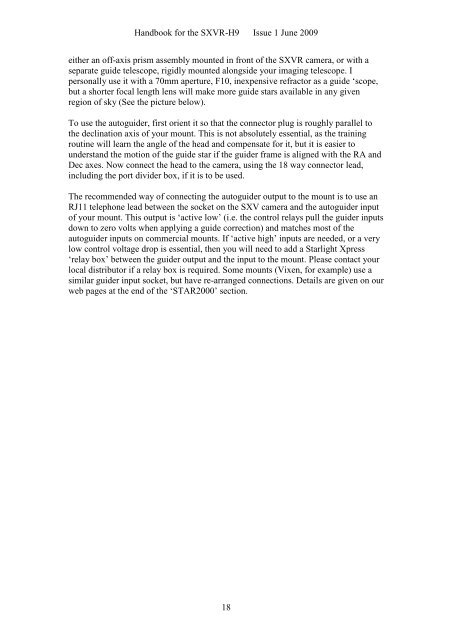SXVR-H9 handbook.pdf - Starlight Xpress
SXVR-H9 handbook.pdf - Starlight Xpress
SXVR-H9 handbook.pdf - Starlight Xpress
Create successful ePaper yourself
Turn your PDF publications into a flip-book with our unique Google optimized e-Paper software.
Handbook for the <strong>SXVR</strong>-<strong>H9</strong> Issue 1 June 2009<br />
either an off-axis prism assembly mounted in front of the <strong>SXVR</strong> camera, or with a<br />
separate guide telescope, rigidly mounted alongside your imaging telescope. I<br />
personally use it with a 70mm aperture, F10, inexpensive refractor as a guide ‘scope,<br />
but a shorter focal length lens will make more guide stars available in any given<br />
region of sky (See the picture below).<br />
To use the autoguider, first orient it so that the connector plug is roughly parallel to<br />
the declination axis of your mount. This is not absolutely essential, as the training<br />
routine will learn the angle of the head and compensate for it, but it is easier to<br />
understand the motion of the guide star if the guider frame is aligned with the RA and<br />
Dec axes. Now connect the head to the camera, using the 18 way connector lead,<br />
including the port divider box, if it is to be used.<br />
The recommended way of connecting the autoguider output to the mount is to use an<br />
RJ11 telephone lead between the socket on the SXV camera and the autoguider input<br />
of your mount. This output is ‘active low’ (i.e. the control relays pull the guider inputs<br />
down to zero volts when applying a guide correction) and matches most of the<br />
autoguider inputs on commercial mounts. If ‘active high’ inputs are needed, or a very<br />
low control voltage drop is essential, then you will need to add a <strong>Starlight</strong> <strong>Xpress</strong><br />
‘relay box’ between the guider output and the input to the mount. Please contact your<br />
local distributor if a relay box is required. Some mounts (Vixen, for example) use a<br />
similar guider input socket, but have re-arranged connections. Details are given on our<br />
web pages at the end of the ‘STAR2000’ section.<br />
18

















